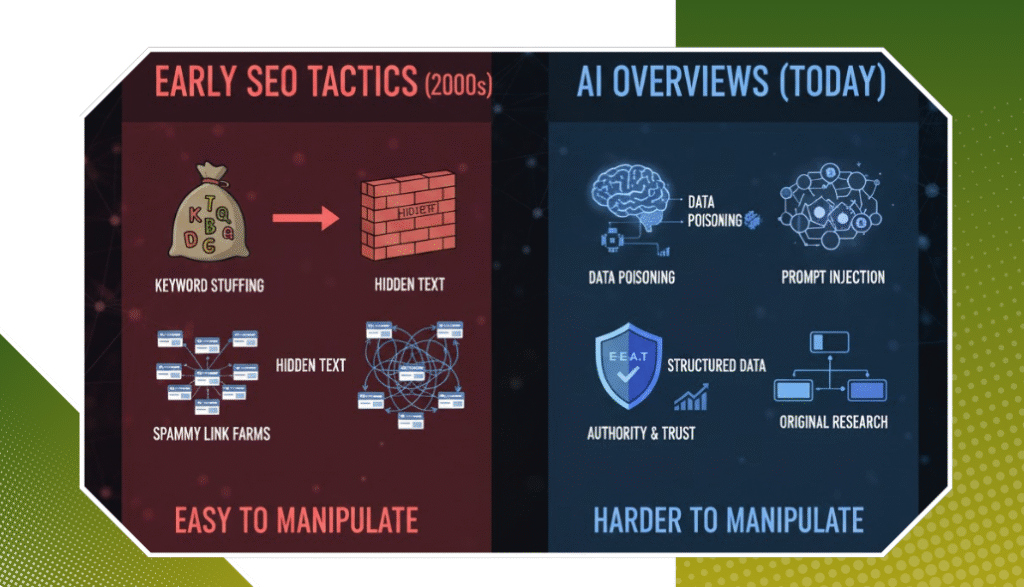While this offers convenience, it also forces marketers to rethink how SEO works. In this blog, we will get to know how Google AI Overview is changing the rules of search, what it means for your website traffic, and how to adapt your strategy to stay ahead.
What Are AI Overviews in Google Search?
AI Overviews are generative summaries that appear prominently in Google Search results. Unlike featured snippets that quote a single source, AI Overviews synthesise information from multiple authoritative websites to deliver a comprehensive answer.
These summaries are designed to serve users quickly and efficiently, especially for informational queries. According to Ahrefs, 99.2% of AI Overviews are triggered by informational search intent, such as “how to,” “what is,” or “why does” queries.
The feature was first introduced as part of Google’s Search Generative Experience (SGE) in 2023 and has since expanded globally. AI Overviews now appear in nearly 47% of all search queries, with the highest frequency in the healthcare, finance, and education sectors.
The Impact on Organic Traffic
The most immediate consequence of AI Overviews is a sharp decline in organic traffic. A study by SparkToro found that over 58% of Google searches now result in zero clicks. This trend is particularly pronounced for websites that provide straightforward, informational content.
A Semrush analysis of 10,000 keywords revealed that AI Overviews significantly reduce both organic and paid CTRs. This shift forces SEO professionals to reassess and rethink their approach. Ranking on page one is no longer enough; your content must offer unique value that compels users to click, even when a summary is already visible.
What Are the Key SEO Challenges Introduced by AI Overviews?
AI Overviews present several challenges for traditional SEO strategies:
- Reduced Visibility: Organic listings are pushed below the fold, making them less likely to be seen or clicked.
- Content Devaluation: AI may summarise your content without driving traffic to your site.
- Measurement Gaps: Google Search Console currently offers limited visibility into AI Overview impressions and clicks.
These challenges need a shift in focus from simply ranking high to becoming a trusted and cited source within AI-generated content.
How to Adapt Your SEO Strategy?
To remain competitive, businesses must evolve their SEO strategies to align with the new AI-first search approach. Here’s how:
1. Focus on Content Depth and Originality
AI Overviews are excellent at summarising surface-level content. To stand out, your content must offer depth, nuance, and original insights. This includes:
- Expert commentary
- Proprietary research
- Case studies and real-world examples
This approach definitely improves your chances of being cited and also encourages users to click through for more detailed information.
2. Use Structured Data and Schema Markup
Structured data helps Google understand your content’s context and hierarchy. Implementing schema types, including FAQ, HowTo, and Article, can improve your eligibility for inclusion in AI Overviews in Google. Additionally, well-structured content with clear headings, bullet points, and concise summaries increases your chances of being featured.
3. Optimise for User Intent and Long-Tail Queries
Understanding the intent of users is more critical than ever with the rise of voice search & conversational queries. Instead of targeting broad keywords, focus on long-tail phrases that reflect specific user needs.
For example, instead of “content marketing,” target “how to build a content marketing funnel for SaaS.” This strategy aligns with how AI Overviews interpret and respond to queries. This is where content planning becomes essential. Use tools like Google Trends, Semrush, and AnswerThePublic to identify trending questions and tailor your content accordingly.
4. Improve Page Experience and Engagement Signals
Google’s algorithms consider user engagement metrics such as bounce rate, time on page, & scroll depth. Enhancing your site’s UX can improve these signals and increase your chances of being cited. Incorporate multimedia elements like videos, infographics, and interactive tools to make your content more engaging and harder to summarise.
Opportunities Within AI Overviews
Despite the challenges, AI Overviews also present new opportunities:
- Citation Visibility: Being cited in an AI Overview can boost brand authority and trust.
- Topical Authority: Consistently publishing high-quality content on a specific topic can position your site as a go-to source.
- Content Differentiation: AI struggles with originality. Use this to your advantage by offering unique perspectives and expert insights.
The real key here is ‘strategic keyword research.’ Identify gaps in existing AI Overviews and create content that fills those voids with clarity and authority.
What Are the Best Tools & Metrics to Monitor Your Performance?
To measure your SEO performance in the age of AI Overviews, leverage the following tools:
- Google Search Console: Monitor impressions, clicks, and ranking positions.
- Google Analytics 4: Track user engagement and conversion metrics.
- Third-party SEO Platforms: Tools like Ahrefs and Semrush now offer filters to track AI Overview-triggered keywords.
What you should keep your eye on are metrics such as CTR, bounce rate, and scroll depth to understand how users interact with your content after the AI Overview rollout.
Conclusion
AI Overviews in Google Search are transforming the SEO landscape. While they offer users faster, more comprehensive answers, they also reduce organic visibility and challenge traditional SEO tactics. To succeed in this new horizon, businesses must adapt by creating high-value, original content that goes beyond what AI can summarise. Focus on user intent, structured data, and strategic keyword research to optimise your content. With that, you can position your content to thrive, even in a zero-click world. SEO isn’t dead, it’s evolving. And those who evolve with it will lead the next generation of search visibility.




